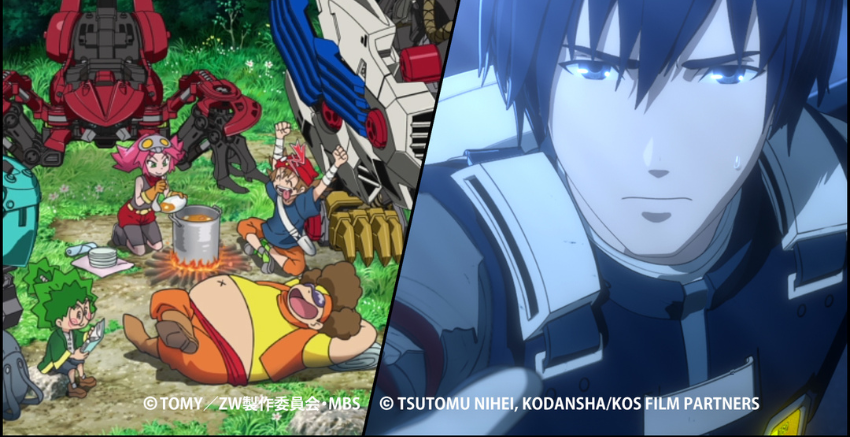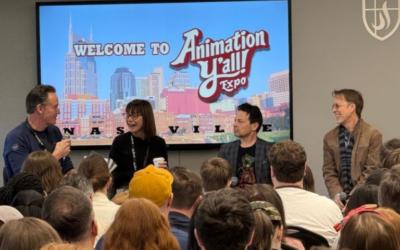©TOMY/ZW製作委員会・MBS ©TSUTOMU NIHEI, KODANSHA/KOS FILM PARTNERS
The debate of computer graphics (CG) versus hand drawing has begun! In the past couple of years, CG has climbed the ranks in the western hemisphere, but what about in Japanese animation? To get to the bottom of this, SIGGRAPH sat down with Marc Salvati (OLM Digital, Inc.) and Andreas Bauer (Polygon Pictures Inc.) to learn more about their SIGGRAPH 2022 Course “The Use of CG in Japanese Animation.” Do you know which one you prefer? Read below to help solidify your decision.
SIGGRAPH: Talk about the process for developing your Course. What inspired you to begin exploring the use of CG in Japanese animation?
Marc Salvati (MS): I have never seen any course at SIGGRAPH about the making of Japanese animation. Traditionally, Japanese animation is only hand-drawn but recently since CG has been increasingly used, I thought it would be of interest to the SIGGRAPH audience. I contacted various companies to see if they would be interested in participating so we could show how hybrid and full-CG Japanese animation is made.
The use of CG at OLM Digital, Inc. is mostly driven by budget. We see it mostly as a medium to make some shots possible within the tight budget given. We decide early for each shot which method we use: CG or hand-drawn. If it is cheaper, we use CG. CG is typically cheaper for mechanical assets like robots and cars and for backgrounds with dynamic camera moves.
Andreas Bauer (AB): Polygon Pictures Inc. in Japan is by now the oldest still-independent CG company in the world. We were founded 39 years ago, which makes us older than Pixar. Of course, there had been other CG pioneering companies before, but these have all since closed or were purchased and incorporated into larger media conglomerates.
Initially, Polygon focused mainly on advertisement, art, and music videos as well as game cinematics. It was somehow by accident that Polygon happened to move into full-CG Japanese animation production. Our first such project was “TRON: Uprising” in 2012 for Disney XD, with art designs by the brilliant Alberto Mielgo. At first, Polygon was to produce only the backgrounds, vehicles, and character bodies, and character faces were to be hand-animated by another company. But the integration of 2D hand-drawn facial elements with CG turned out to be really challenging. Thirteen years ago that kind of integration technology was not really there yet, so it was decided we try to do everything in CG, including full characters.
Since the result turned out surprisingly well, even by today’s standards, Polygon decided to try other full-CG anime projects, which came to be “Knight of Sidonia” and then “Ronja, the Robber’s Daughter,” which was a cooperation with Studio Ghibli. “Knights of Sidonia” is a futuristic story set in outer space with lots of flying, boxy looking mecha robots, which were simple to achieve in CG. The organic shapes in “Ronja, the Robber’s Daughter” turned out to be quite a challenge and would still be considered challenging today.
Since Polygon Pictures had been producing full-CG Japanese animation for over a decade now, I felt this would be a great opportunity to share with the SIGGRAPH community what we learned throughout this decade. Japanese anime seems to become more and more popular internationally while SIGGRAPH so far had very few presentations about the challenges of replicating the hand-drawn Japanese “anime” style in CG.
SIGGRAPH: Why do you believe western animation companies switched from traditional hand-drawn animation to CG for creating characters?
MS: I think that hand-drawn animation and comics have always had a childish image regardless of the story contents. Switching to CG was a way to change the market to a more diverse and wider public. At that time, technology was associated to male consumers, and it may have helped widen the audience. Maybe there was also the illusion that production would be cheaper thanks to technology.
AB: There were few times in movie history when new visual styles were made possible due to advances in technology. Rare examples are silent films transitioning to talkies or black-and-white film moving to color. It is no accident that the first feature-length color movie was Walt Disney’s “Snow White,” simply because color film at the time required very long exposure, which animated cels had no problem with because they are always filmed frame by frame. In a similar fashion, it is no accident that the very first feature-length CG movie ended up being an animation, Pixar’s “Toy Story,” because CG at the time could not yet replicate photo-realistic objects.
Audiences and studios alike were fascinated from the start by these new technologies, and since photorealistic movies were still too difficult to do in CG, for the longest time animation dominated the feature-length CG movie scene. Which is why, driven by that fascination, I think western animation companies very quickly switched to CG.
Japan never had the kind of budgets available for feature-length CG animation that American companies had access to, which is a key reason why to this day Japan continues to use hand-drawn animation. The typical Japanese “anime” style was historically the result of many cost-cutting inventions with the aim to make Japanese hand-drawn animation cheaper to produce than western hand-drawn animation. Consequently to this day, Japanese hand-drawn animation remains very cost-competitive even compared to full-CG productions, which also means gathering a budget for a full-CG animation is very challenging.
SIGGRAPH: Detail the key challenges of attempting to recreate a hand-drawn look within a full CG production. How did you recreate elements such as hair, eyes, and shadows?
MS: Japanese animation has a peculiar timing style: only one drawing every 2-3 frames within 24 frames per seconds. This results in 8-12 drawings per seconds, which requires very few keyframe drawings. This was all designed to save on time and consequently money. In CG we can get rid of this constraint, we can use interpolation of motion, but this falls flat for the Japanese audience because it does not look like “anime” anymore. This peculiar timing became part of the Japanese style, and generations of animators are now not only used to it but take advantage of this constraint to create amazing animations.
We struggle to recreate the cheats used by hand-drawn animation where anything can get stretched, exaggerated at any time. In this context, animation curve interpolation, motion blur, global illumination, and so many other cool features need to be adapted or removed for artistic consistency. Animators and riggers need to fight with the 3D mesh volumes to create non-existing shapes to recreate those cheats. It is very hard to fit the discrete and discontinuous hand-drawn animations into the smooth and continuous CG world. Backgrounds are very detailed with exaggerated perspectives, and they are rarely animated in traditional Japanese animation. However, CG enables fancy camera work, and we had to find solutions to animate the backgrounds while keeping the traditional feel.
AB: The Japanese “anime” style was born from budgetary constraints. From the very beginning the goal had been “artistic simplification” and, to that effect, many shortcuts had been invented. To retain this look in CG, one must try to replicate these artistic simplifications. And therein lies the challenge, because CG does not automatically simplify anything. To the contrary, it always faithfully renders every object detail, 100% accurate from every angle. All this visual complexity needs to be removed.
For example, with hair, it was impossible to hand-draw individual hairs frame by frame, so hair was drawn as larger strands, the fewer the better, which ultimately resulted in the creation of the by now typical “anime hair” depicted by just a few triangles or cones. Eyes have traditionally always been drawn overly large, partly perhaps because Japanese people perceive foreigners to have bigger eyes which they consider to be more beautiful. Also, it is likely due to artistic simplifications. Most other facial features had been removed, so the eyes became the sole focus for nearly all emotional facial expressions, and larger eyes make these expressions much easier to draw. In CG productions, overly large and expressive eyes require additional preparations for textures, eye highlights, and rigging. Shadows have traditionally been greatly simplified in hand-drawn animation, just like with hair, in order to avoid having to draw all that detail, but also to mimic soft shadows which tend to be simpler and rounder.
With CG on the other hand, especially when using ray tracing, shadows are always a perfect projection of the object shape, revealing every tiny detail — which is the opposite of what is desired. Even on live-action movie sets, many lights are used to deliberately shape the shadows and create that perfect shadow line. CG in Japan is not at that level of sophistication; we cannot use that many lights. It is challenging to achieve the simplification found in hand-drawn shadows, reducing all that shadow detail using just a single light.
SIGGRAPH: Can you share why you chose productions like “Zoid Wild,” “Knights of Sidonia,” “Ronja, the Robber’s Daughter,” “Ajin,” “Levius,” “Human Lost,” “Drifting Dragons,” and “Pacific Rim: The Black” to base your research on?
MS: I tried to focus on the use of CG in hybrid productions which blend hand-drawn elements with CG. CG is mainly being used for mechanical objects, therefore presenting “Zoid,” a production showcasing robots, makes the most sense.
AB: Since I have been with Polygon for nearly 12 years, I have the unique opportunity to present the complete evolution of our CG anime style. By using various examples from the past 12 years, I intended to demonstrate all the challenges and progress we made with each design evolution. My hope is that by comparing our early designs like — “TRON: Uprising,” “Knights of Sidonia,” and “Ronja, the Robber’s Daughter” with our very latest designs from “Pacific Rim: The Black” or “Human Lost” — will give the audience a more complete picture of the increasing difficulties and challenges involved.
SIGGRAPH: Who is the optimal audience for your Course?
MS and AB: Japanese animation lovers of all ages! The Japanese animation style is a very important subgenre of non-photoreal CG to us, which is why we hope that our Course attracts everyone who is interested in non-photoreal rendering.
SIGGRAPH: What advice do you have for someone looking to submit to Courses for a future SIGGRAPH conference?
MS: It’s very important to choose early the production you want to showcase and the images and movies you want to use because you have to secure the digital rights. Obtaining these rights takes a lot of time, don’t underestimate it. Be sure to involve other companies in the process. It helps to share the burden and mature your content. Plus, decide early how to split the different parts.
AB: It is very likely that you will have to adapt your course materials at the eleventh hour because you could not secure the rights to some of the images or movie clips you intended to use. Plan ahead for these unexpected revisions. Preparing a course, especially if you need to submit a video recording and English subtitles file, will take a lot more time than you think. Be sure to have ample time and resources available.

Marc Salvati came to Japan in 2004 as a computer graphics Ph.D. student at the Tokyo Institute of Technology. He made his whole career at the research and development department of OLM Digital, Inc. since 2008. He started as a software engineer and developed various plugins for Maya and After Effects. Now, he directs a team of developers and researchers covering all OLM Digital needs in CG and traditional animation.

Andreas Bauer is shader writer at Polygon Pictures Inc. in Japan. After earning a master’s degree with distinction in computer animation from Bournemouth University, England, Bauer worked as shader writer at Framestore in London and Sony Pictures Imageworks in Los Angeles before joining Polygon Pictures in Tokyo, where he currently specializes in non-photorealistic rendering with a focus on hand-drawn styles and new hybrid designs. For the past decade, Bauer has been developing the cel shading and contour rendering pipeline at Polygon Pictures, devising new methods to mimic the traditional Japanese anime look as faithfully as possible with CG.



